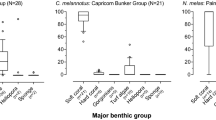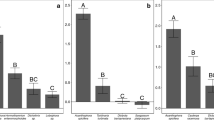Abstract.
The soft corals Sinularia maxima and S. polydactyla contain identical bioactive metabolites which, at natural concentrations, deter feeding by many generalist predatory reef fishes. The range of these metabolite concentrations in the soft corals can vary over time and between sites. During a 2 year period between October 1994 and September 1996 on Guam there were significant temporal differences in concentrations of the two major defensive metabolites, pukalide and 11β-acetoxypukalide, of these soft corals. However, no seasonal patterns emerged from the temporal analyses. There were also site-specific differences in these chemical constituents despite habitat similarities; two sites on Guam separated by approximately 30 km exhibited a twofold difference in levels of the defensive metabolite pukalide, and sites throughout the tropical Northwest Pacific showed as much as a fivefold difference. Transplantation of the soft corals between the two sites on Guam for an 8 month period resulted in as much as a 27% change in pukalide concentrations, while back-transplanted handling controls exhibited no change. There were also significant differences in the number of bite scars (i.e. fish predation events) on the soft corals at the two sites following transplantation, suggesting the intensity of predation might be responsible for site-specific changes in defensive metabolite levels, although it is impossible to rule out other interactive effects at this time. Video transects indicated a six- to sevenfold greater number of butterflyfish at one of these sites, which resulted in a higher predation rate (as bites m–2 h–1); the populations of soft corals at this site exhibited higher levels of pukalide than populations at the low-predation site. This study provides preliminary evidence that the spatial variability in the chemical constituents of the soft corals S. maxima and S. polydactyla is a plastic phenotypic response that might be due to localized predation pressures.
Similar content being viewed by others
Author information
Authors and Affiliations
Additional information
Electronic Publication
Rights and permissions
About this article
Cite this article
Slattery, .M., Starmer, .J. & Paul, .V. Temporal and spatial variation in defensive metabolites of the tropical Pacific soft corals Sinularia maxima and S. polydactyla. Marine Biology 138, 1183–1193 (2001). https://doi.org/10.1007/s002270100540
Received:
Accepted:
Issue Date:
DOI: https://doi.org/10.1007/s002270100540




